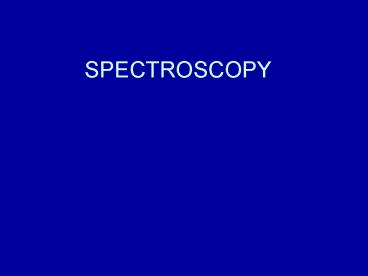SPECTROSCOPY PowerPoint PPT Presentation
1 / 16
Title: SPECTROSCOPY
1
SPECTROSCOPY
2
Textbook and reference
- Textbook
- Kenneth A Rubinson Judith F Rubinson,
Contemporary Instrumental Analysis(??????), ?????
- Gary D. Christian, Analytical Chemistry, 3rd Ed.,
John Wiley Sons - Reference
- ????????,????,???????,2001
- ?????????,????? (????????????????????)???????,1994
??2? - ??????????????????????????????,??????
???????,1987??1? - ???????????,????? ?????????,2002.8
3
Chapter 1 Introduction 1. Spectroscopy
- What is spectroscopy?
- A typical spectroscopy experiment is
extremely simple to describe. Electromagnetic
radiation at some frequency is allowed to
interact with the sample of interest. Then some
property of that radiation is measured, for
example the amount absorbed, diffracted, emitted,
scattered, etc. The frequency of radiation to be
used is determined by the energy levels
associated with the property of the sample we are
interested in such as electronic levels,
rotational motion, vibrational motion, etc.
4
- Spectroscopy includes UV-Vis spectrometry
(Ultraviolet/visible Absorption Spectrometry), IR
spectrometry (Infrared Spectrometry), NMR
(Nuclear Magnetic Resonance Spectroscopy) and MS
(Mass Spectrometry) - Rapid and precise analytical methods for organic
compounds - Only applied for pure compound
- Hyphenated techniques (GC-MS, GC-IR, LC-MS,
LC-NMR etc.) for mixture analysis
5
2. Electromagnetic spectrum
- The wave is described with wavelength and
frequency - Electromagnetic radiation possess a certain
amount of energy. The energy of one unit of the
radiation, the photon, is related to the
frequency by - E hv
- E is the energy of the photon in ergs, h is
Plancks constant, 6.62 x 10-27 erg sec
6
The electromagnetic spectrum
- The electromagnetic spectrum is very wide and
covers radiation from gamma-rays to visible light
to radiofrequency waves. - The visible region is that narrow region of the
electromagnetic spectrum to which the color
sensors in our eyes are sensitive. This region,
which covers wavelengths of 300 nm to 800 nm, has
energies which are just below the carbon-carbon
bond strength.
7
(No Transcript)
8
g-rays
- g-rays are also known to cause tissue damage.
These are very high energy electromagnetic waves
and are often generated during decay of
radioactive materials. Usually some dense
material like lead is necessary to keep them
contained. Aside from their use in radioactive
labelling experiments, they are also used in
Mossbauer spectroscopy which is used to
investigate nuclear structure. The fact the
g-rays can destroy a nuclei also make them useful
for probing properties of nuclei.
9
X-rays
- X-rays can cause damage to tissue and usually
interact with living matter by breaking bonds.
The energies associated with x-rays are
definitely above the bond energies. This is why
they are used in the treatment of localized
tumors and they are also known to increase the
risk of cancer as well. X-rays are used to study
biological molecules through several processes
such as scattering and diffraction. Biophysical
applications of x-rays are concerned mostly with
the diffraction experiment where detailed
information about biopolymer structure can be
obtained. X-rays can be used for this mainly
because its wavelength (typically used are the Ka
band of Cu, 1.54A, or Mo, 0.71A) is on the order
of the length of a chemical bond. We often talk
of the type of X-rays used in wavelengths on the
angstrom level or in terms of their energies.
10
Ultraviolet radiation
- invisible electromagnetic radiation between
visible violet light and X rays it ranges in
wavelength from about 400 to 4 nanometers and in
frequency from about 10 15 to 10 17 hertz. It is
a component (less than 5) of the sun's radiation
and is also produced artificially in arc lamps,
e.g., in the mercury arc lamp.
11
Visible light
- The visible region of the electromagnetic
spectrum consists of photons with wavelengths
from approximately 400 to 700 nm. The short
wavelength cutoff is due to absorption by the
lens of the eye and the long wavelength cutoff is
due to the decrease in sensitivity of the
photoreceptors in the retina for longer
wavelengths. Light at wavelengths longer than 700
nm can be seen if the light source is intense.
12
(No Transcript)
13
Infrared radiation IR
- If we travel the other direction down the
electromagnetic spectrum from visible light, we
discover the infrared region. This region can be
used to sense heat since it generates heat as a
by-product of the vibrations it induces. IR is
used to investigate vibrational modes of
molecules. It is usually measured in wave
numbers (cm-1) which is the inverse of the
wavelength of the IR radiation.
14
Microwaves
- Microwaves can be used to investigate the
rotational properties of molecules as well as
electron spin properties. EPR NMR. At these
frequencies, there is no appreciable spontaneous
emission and we must rely on the surroundings to
provide or absorb the energy to attain
equilibrium. All emissions are now stimulated.
This applies both to NMR and EPR. Unlike other
spectroscopies, we can change the sensitivity not
only by temperature but also by increasing the
magnetic field used to split the spin energy
levels. We are allowed to fine tune the
Boltzmann distribution. This is only one of the
reasons NMR spectroscopist keep buying more
powerful magnets.
15
Absorption
- Matter can capture electromagnetic radiation and
convert the energy of a photon to internal
energy. This process is called absorption. - Absorption spectroscopy is one way to study the
energy levels of the atoms, molecules, and
solids. An absorption spectrum is the absorption
of light as a function of wavelength. The
spectrum of an atom or molecule depends on its
energy-level structure, making absorption spectra
useful for identifying compounds.
16
Adsorption Spectrum

